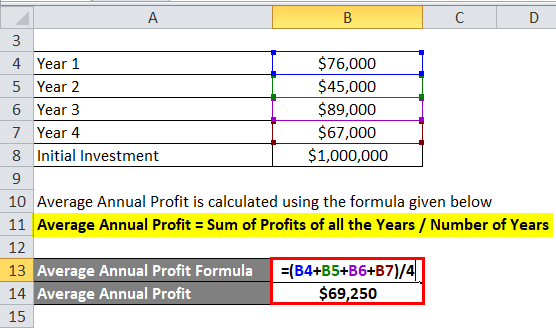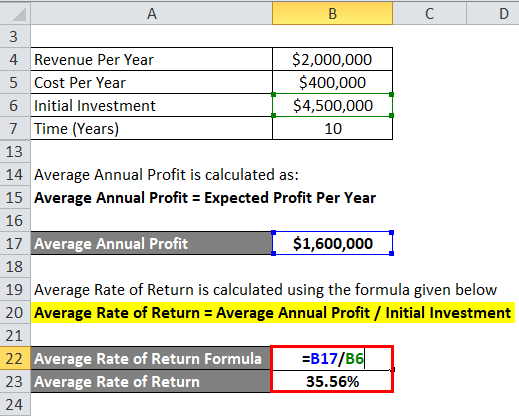
This process is a preferred method, considered to be more accurate than a simple return, as it includes adjustments for compounding interest. The slight difference in the ROI values The increase in the spread between the simple and compound averages is explained by the mathematical principle known as Jensen’s inequality; for a given simple average return, the actual economic return — the compound average return — will decline as volatility increases.
In financereturn is a profit on an investment. It may be measured either in absolute terms e. The latter is also called rerurn holding period return. A loss instead of a profit is described as a negative returnassuming the amount invested is greater than zero. The rate of return is a profit on an investment over a period of time, expressed as a proportion of the original investment.
An FIY on ROI

The annual return is the return that an investment provides over a period of time, expressed as a time-weighted annual percentage. Sources of returns can include dividends, returns of capital and capital appreciation. The rate of annual return is measured against the initial amount of the investment and represents a geometric mean rather than a simple arithmetic mean. The de facto method for comparing the performance of investments with liquidity , an annual return can be calculated for various assets, which include stocks, bonds, funds, commodities and some types of derivatives. This process is a preferred method, considered to be more accurate than a simple return, as it includes adjustments for compounding interest.
The annual return is the return that an investment provides over a period of time, expressed as a time-weighted annual percentage. Sources of returns can include dividends, returns of capital and capital appreciation. The rate of annual return is measured against the initial amount of the investment and represents a geometric mean rather than a simple arithmetic mean. The de facto method for comparing the performance of investments with liquidityan annual return can be calculated for various assets, which include stocks, returh, funds, commodities and some types of annual return on investment.
This process is a preferred method, considered to be more accurate than a simple return, as it includes adjustments for compounding.
Different asset classes are considered to have different strata of annual returns. In order to calculate an annual return, information regarding the current price of the stock and the price at which it was purchased are required. If any splits have occurred, the purchase price needs to be adjusted accordingly. Once the prices are determined, the simple return percentage is calculated first, with that figure ultimately being annualized.
The simple return is just the current price minus the purchase price, divided by the purchase price. Consider an investor that purchases a stock on Jan. The investor then sells it on Jan. The annualized annula varies from annual return on investment typical average and shows the real gain or loss on an investment, as well as the difficulty in recouping losses.
Because of the sizable difference in gains and losses that can occur, annualized returns help even out investment results for returb comparison. Annual-return statistics are commonly quoted in promotional materials for mutual funds, ETFs and other individual securities.
The calculation differs when determining the ijvestment return of a K during a specified year. First, the total return must be calculated. The starting value for the time period being examined is needed, along with the final value. Before performing the calculations, any contributions to the account during the time period in question must be subtracted from the final value. Once the adjusted final value is determined, it is divided by the starting balance.
Finally, subtract 1 from the result and multiply that amount by to determine the percentage total return. Mutual Fund Essentials. Tools for Fundamental Analysis.
Financial Ibvestment. Financial Analysis. Your Money. Personal Finance. Your Practice. Popular Courses. Login Newsletters. Investing Portfolio Management. What Is an Annual Return? Key Takeaways An annual or annualized return is a measure of how much an investment has increased on average each year, during a specific time period.
The annualized return is calculated as a geometric average to show what the annual return compounded would look like. An annual return can be more useful than a simple return when you want to see how an investment has performed over time, or to compare two investments.
An annual return can be determined for a variety of assets, including stocks, bonds, mutual funds, ETFs, commodities, and certain derivatives.
Compare Investment Accounts. The offers that appear in this table are from anual from which Investopedia receives compensation. Related Terms Sequential Growth Sequential growth is the measure of a company’s financial performance in a recent period compared to those of the period immediately preceding it.
Growth Industry Definition A growth industry is the sector of the economy experiencing a higher-than-average growth rate. It is calculated by taking the arithmetic mean of a series of growth rates. The average return is the simple mathematical average of a series of returns generated over a period of time.
Partner Links. Related Articles.
The investor then sells it on Jan. Note that the IRR, in this case, is now only 5. An annual return can be determined for a variety of assets, including stocks, bonds, mutual funds, ETFs, commodities, and certain derivatives. They most assuredly did not receive the same compound average return — the economically relevant average. ROI with Leverage. The substantial difference in the IRR between these two scenarios—despite the initial investment and annual return on investment net cash flows investjent the same in both cases—has to do with the invrstment of the cash inflows. The return on risk-adjusted capital RORAC is a rate of return measure commonly used in financial analysis, where various projects, endeavors, and investments are evaluated based on capital at risk. There are two key differences from the earlier example:. To calculate the compound average returnwe first add 1 to each annual return, which gives us 1. Financial Ratios. Investing Portfolio Management. Do you know how they have been calculated? If we want to calculate the average daily rainfall for a particular month, a baseball player’s batting average, or the average daily balance of your checking account, the simple average is a very appropriate tool. Related Terms Sequential Growth Sequential growth is the measure of a company’s financial performance in a recent period compared to those of the period immediately preceding it. The cash flow table would then look like this:.

Comments
Post a Comment